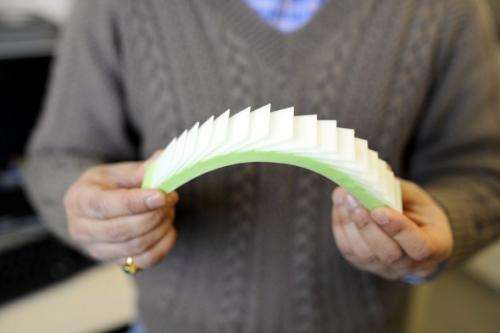Scaling up armor systems

Dermal modification is a significant part of evolution, says Ranajay Ghosh, an associate research scientist in the College of Engineering. Almost every organism has something on its skin that provides important survival properties such as protection from predators, camouflaging, thermal regulation, and sensorial functions. In many animals, this evolution has led to the formation of scales.
This is why Ghosh and his colleagues in Northeastern University's High Performance Materials and Structures Laboratory are looking to the properties of animal scales to help them develop the next generation of armor systems. The lab studies the mechanical behavior and performance of materials and structures, at various scales from nanowires and living cells to ships and buildings.
Led by associate professor Ashkan Vaziri, the lab's findings were recently published in the journal Applied Physics Letters, being featured on the cover of one of December's issues. Hamid Ebrahimi, PhD'17, who is pursuing her doctorate in mechanical engineering, was also a co-author.
"The next generation of armor systems are light, perform a lot of functions, and at the same time do not compromise on protection," Ghosh said, "and nature provides very important information in terms of armor development."
The research, which is supported by the National Science Foundation and Qatar Foundation, involved examining different strategies for general protective systems that are lightweight and multi-use across industries.
The researchers chose to mimic the properties of fish scales because fish, like a person wearing armor, need a fine balance between mobility and protection, Ghosh explained. Using 3-D printing, the researchers created models of fish scales that were embedded in a soft substrate. Adding these scales caused the soft substrate to stiffen up, a response the researchers found could be achieved rather quickly because of the scales' size and placement within the substrate.

"This is very different from what people have been working on before, which is focusing on the very nature of the scales themselves, how they will behave, and whether they break easily or not," he added. "Here, our focus is simply the effect of simple scales and their mutual contact and interaction with the soft substrate."
Ghosh said the research also identifies that even with pedestrian mechanical properties, nature has developed very complex systems.
In this project, the researchers' work focused on examining the impact that adding scales would have on the substrate's elasticity. Having found this makes the substrate stiffer and less penetrable, the next step is determining how this work can help create tougher armor. The lab plans to continue with more advanced testing on fish scales' protective properties, with the ultimate goal of combining the properties of several different animals' scales into one armor system. The mobility of snake scales and the optics of butterfly wings are among these intriguing properties the lab hopes to investigate, he said.
"We can synthesize what nature could not do because we have more flexibility with the materials we use," Ghosh said.
Journal information: Applied Physics Letters
Provided by Northeastern University





















